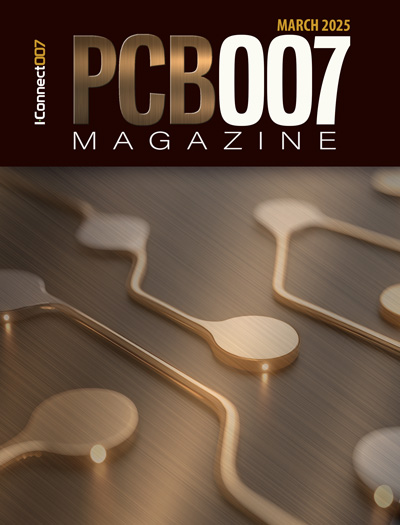-

- News
- Books
Featured Books
- pcb007 Magazine
Latest Issues
Current Issue
Voices of the Industry
We take the pulse of the PCB industry by sharing insights from leading fabricators and suppliers in this month's issue. We've gathered their thoughts on the new U.S. administration, spending, the war in Ukraine, and their most pressing needs. It’s an eye-opening and enlightening look behind the curtain.

The Essential Guide to Surface Finishes
We go back to basics this month with a recount of a little history, and look forward to addressing the many challenges that high density, high frequency, adhesion, SI, and corrosion concerns for harsh environments bring to the fore. We compare and contrast surface finishes by type and application, take a hard look at the many iterations of gold plating, and address palladium as a surface finish.

It's Show Time!
In this month’s issue of PCB007 Magazine we reimagine the possibilities featuring stories all about IPC APEX EXPO 2025—covering what to look forward to, and what you don’t want to miss.
- Articles
- Columns
Search Console
- Links
- Media kit
||| MENU - pcb007 Magazine
Copper Filling of Blind Microvias and Through-holes Using Reverse-pulse Plating
July 22, 2014 |Estimated reading time: 1 minute
Abstract
This article describes the different techniques of via filling and their characteristics. It points out the advantages of reverse pulse plating and how the technology has been modified to approach new market requirements such as thicker core substrates and laser drilling of through holes. The current capability of the system for inclusion-free filling and the areas where development is ongoing is demonstrated.
Introduction
Laser drilling of blind microvias (BMVs) and subsequent copper filling has become the standard manufacturing technique for high density interconnects. To reach the required interconnect density and to provide the necessary surface for reliable solder attachment in IC packaging, copper-filled BMVs are used. For smartphone production, the use of multiple lamination and typically 10 layers of stacked copper BMV filling is now the preferred technology. This is also known as the “any layer” filling process. To maintain the development in circuit miniaturisation together with the reduction in overall processing costs as expected by Moore’s Law and to meet the demand for ever more filled BMVs on each plated layer, advances in filling processes are required.
Via Filling Process
Copper plating and filling can be described as shown in Figure 1.
Capture pad is the connection area of a surface feature to the inner layer beneath. Recess describes the remaining non-copper filled area on top of a copper filled feature (trench, microvia, through-hole) in relation to the copper plated on the board surface. Inclusions are non-copper filled voids within PCB features.
The filling of blind microvias without additives (normal deposition) will usually lead to the formation of a void. Copper is deposited until the via is closed, but without additives less copper is deposited inside the BMV than on the surface and voids may occur. Read the full article here.Editor's Note: This article originally appeared in the May 2014 issue of The PCB Magazine.


